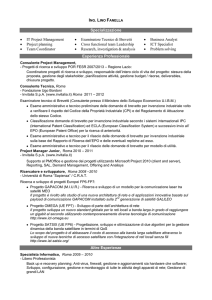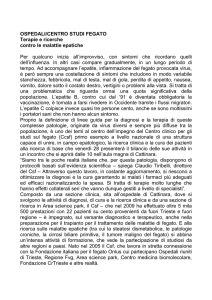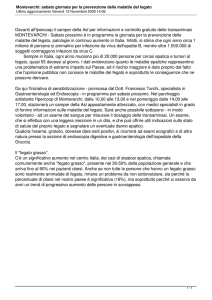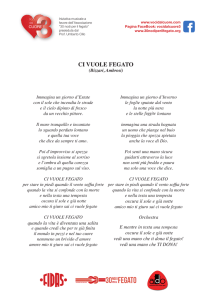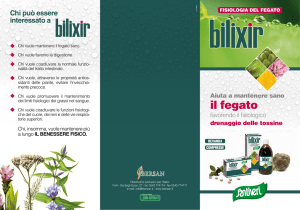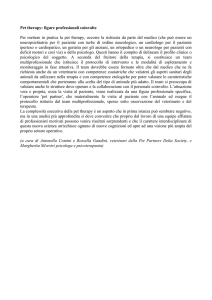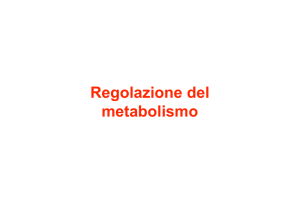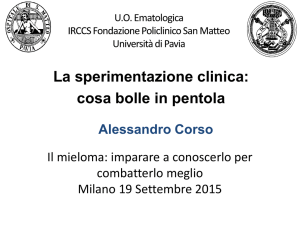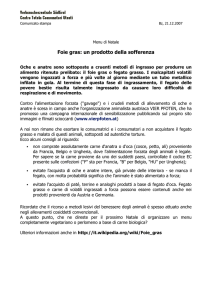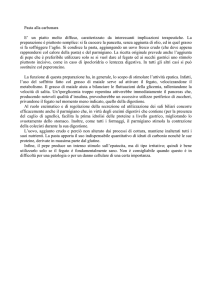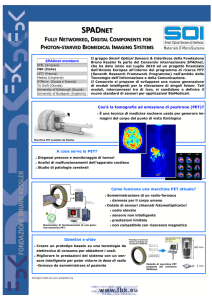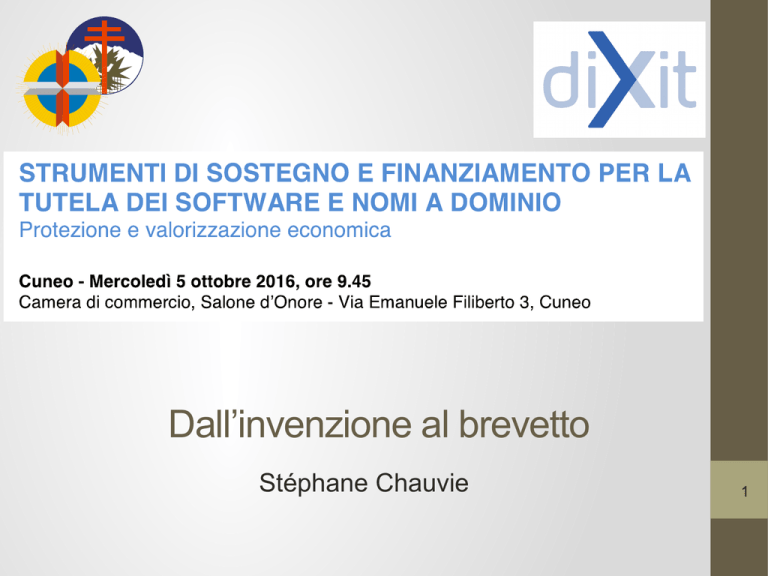
Dall’invenzione al brevetto
Stéphane Chauvie
1
Stéphane Chauvie
responsabile ff
della
co-founder of
a spin-off of
SC Fisica Sanitaria
Ospedale Santa Croce e Carle, Cuneo
UNITO
2
born on Mar 4th, 2011
Team
Advisers
Management
Alexandru Stancu, general manager
10+ years of SW development
1 start up
Associate professor of
Oncology, Université
de
Nice
Dr. A. Biggi
Piergiorgio Cerello, co-founder
Senior Researcher at INFN, Torino, IT
20+ years of SW development
10+ years in Medical Physics
Head of Nuclear
Medicine Unit,
S. Croce e Carle
Hospital, Cuneo
Dr. G. Barra
Stephane Chauvie, co-founder
Head of Medical Physics Unit,
Croce Carle Hospital,
Cuneo, IT
Prof. A. Gallamini
S.
Senior Executive
Medical Imaging in Clinical Trials
Worldwide Reliability. In real time
Imaging in Clinical Trials
Medical
Imaging:
• diagnosi
• stadiazione
• risposta alla
terapia
• follow-up
Ogni farmaco o
nuova tecnologia
prima di arrivare
al
paziente deve
essere testata
in un
trial clinico
™
©
www.widen.it
e’ una piattaforma per lo scambio, la verifica, la
revisione, il management, l’analisi di immgini in clinical
trials
ma e’ soprattutto un
prodotto commerciale
# of Trials
1. Market
Clienti: gruppi cooperativi e industrie farmaceutiche
II Customers
8
III Competitors
Societa’ di Imaging
Contact Research Organization
ICT provider only
IV. Competitive Advantages
Time/Cost Saving
No hardware/software requirements on Trial Sites
Quality Assurance
• Medical Expertise, not just ICT provider
• Common standard PET Scanner Calibration
• Custom Real time Imaging Quality Assessment
• Custom Real time metaData/Image Analysis
V. Barriers to Competition
First to Market
Patents
Not only ICT but with medical
expertise
Large Network
What is a patent?
• A patent is the right to exploit an invention
- NO!
• ius excludendi alios: the right to exclude others
from making, using, selling or importing an
invention. It confers no enabling right.
Myth - IP is just for (large) companies
Patent Attack Plan
• 1) software
• to cover an unsettled issue
• 2) hardware
• a phantom and its analysis
• 3) business method (US only)
• deprecated
• 4) algorithm
• what is today about
Algoritmo per l’identificazione delle
strutture anatomiche e funzionali in
immagini PET/CT
Refertazione di un esame PET
Analisi visiva: il medico analizza l’immagine identificando possibili
regioni patologiche basandosi su un eccessivo accumulo di attivitaà
Analisi semi-quantitativa: si confrontano i conteggi delle zone
indicate dal medico con i conteggi in zone di riferimento; ad es
fegato e MBPS
SUV=
[ A misurata ( Bq/ml)]
A iniettata ( Bq )/ peso ( g )
Analisi quantitativa: si assegna alla regione analizzata un valore che
permetta di stabilire se si tratti di malattia oppure di tessuto sano
PET quantitativa
Molti fattori che influiscono sul SUV
1. Attivitaà iniettata
2. Sincronizzazione degli orologi
3. Peso del paziente
4. Tempo di uptake
5. Attivitaà residua
6. Stravasi
7. Scanner PET
8. Ricostruzione delle immagini
9…..
Pa
te
nt
ed
Pa
te
nt
ed
Inter-calibrazione
degli scanner PET
Verifica in tempo
reale della
qualita’
dell’immagine
Verifica in tempo reale della qualita’
dell’immagine
Controllo di qualità usando
polmoni
riferimenti interni
fegato
cervello
reni
vescica
Il fegato è un organo
riproducibile
Obiettivo:
identificare in modo automatico il
fegato in immagini PET
Come si può identificare
il fegato?
Il fegato è una delle
regioni:
• più estese
• più omogenee
• nella parte destra del
corpo
• intorno al baricentro
L'algoritmo
Trasformazioni
geometriche
Ricerca della posizione
del fegato 2D
Ricerca della posizione
del fegato 3D
L’algoritmo:
ha una sensibilità del 98.4%
nell'identificare la posizione
del fegato
ha una precisione maggiore
del 95% nell’estrarre il SUV
del fegato
è veloce e robusto
Ma e’ brevettabile?
Patent Requirements
A patentable invention must be:
1. Novel/New (Not already been disclosed to the public)
2. Non obvious/Containing an inventive step
3. Useful/be susceptible of industrial application
22
Patent Requirements:
1. Novel/New
• New in relation to that which is known prior to the
date of filing the application
• Known = general availability through the written word
(publications), spoken word (lectures to congress, etc.),
usage, etc.
• What is known prior can include public
information that is available anywhere in the
world
23
New? Perform a patent search
• Patent information is an invaluable source of research information;
much of what appears in patents does not appear in academic and
technical journals
• Data is publicly available (e.g. http://ep.espacenet.com/)
• Most of what is published in patents is not protected, and is therefore
free to use (many patent are abandoned, refused or expired)
24
http://www.epo.org/patents/patent-information/free/espacenet.html
New? Perform a prior search
• Known:
• Literature
• Congress
• Demo
• Internet (e.g. facebook!!!!)
Le due facce del known:
quello che hanno fatto gli altri e quello che
hai fatto tu!!!
NDA con tutti!
Patent Requirements:
2. The Inventive Step
• It is considered to be an inventive step if it
solves a technical problem in a non-obvious
way
• Non-obvious is in relation to a person skilled in
the same field as the invention
• The skilled person is an average expert, not as
expert as the inventor
26
Patent Requirements:
3. Industrial Application
• The invention must have at least one practical
purpose (e.g. industrial application) and must be
reproducible
• No evaluation of quality or economical factors!
• Only the technical qualities are relevant
27
Patent Sections
• Field of the Invention
• Background of the Invention (Prior Art)
• Summary of the Invention
• Description of the Drawings
• Detailed Description of the Invention
(Specification)
• Claims
• Drawings or Figures (first in US)
28
• Patent
number
• Filing
date
• Owner
• Potential
countries
• Priority date
• Inventor(s)
• Title
• Abstract
Field of the Invention
Evidenziare il contesto in cui si muove il
brevetto specificando quale bisogno va a
coprire
NB: For the patent validity the invention has to be described
in a manner which enables a person skilled in the art to
perform the invention
Background of the Invention
Specificare qual’e’ l’ambito in cui si muove il
brevetto evidenziando gli elementi necessari ad
individuare quale siano le mancanze della prior
art che hanno portato gli inventori a proporre il
brevetto.
Summary of the Invention
Esporre i concetti necessari a capire il contesto, la terminologia,
le definizioni, etc… in cui si inserisce il brevetto.
Deve essere esaustivo, l’esaminatore deve riuscire acapire il
brevetto partendo da questa descrizione.
Description of the drawings
Descrizione delle figure allegate al brevetto
Detailed description
Descrizione dettagliata (come non mai) facendo
attenzione a non scendere nel particolare quando
non necessario
Claims
Attenzione: non e’ detto che tutti i claims debbano
passare l’analisi ma e’ necessario che quelli
fondamentali ci siano
Drawings
I drawings sono fondamentali. le parole
possono essere interpretate ma un disegno
e’ auto-esplicativo.
Grazie per l’attenzione
La scelta dei paesi
Grazie per l’attenzione
Per info o domande: [email protected]

